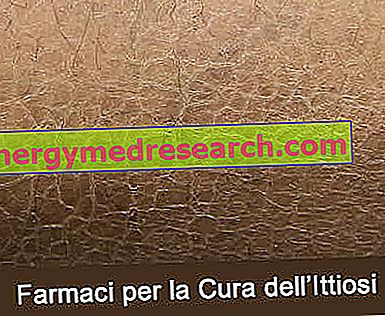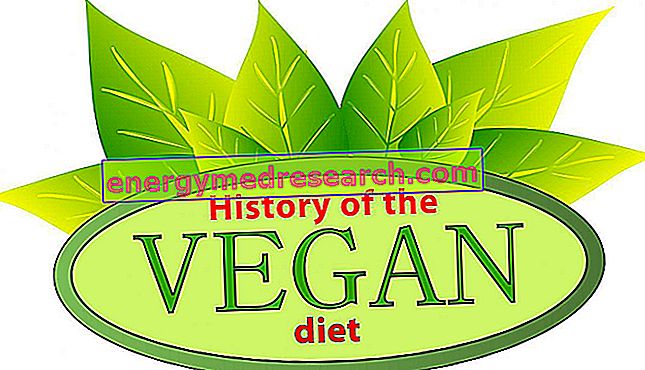What are
What are integral rusks?
The integral rusks are foods derived from cereals, the result of real complex recipes.

The main ingredient is whole wheat wholemeal flour, that is the fiber-rich flour obtained from grinding the seeds of Triticum aestivum .
The integral rusks can be prepared at home but it is basically industrial foods. From the nutritional point of view, they belong to the III fundamental group of foods, therefore rich in starch, fiber, some vitamins and minerals. They lend themselves to most nutritional regimens; on the other hand, in low-calorie diets, they may be poorly recommended due to the higher intake of fat - sprayed even superficially during the production cycle to increase the effect of browning - and of simple sugars - maltose - compared to simple bread.
The wholemeal rusks are the commercial alter ego of bread bruschettas - if desired, also of roasted sliced polenta. The shape is disc or parallelepiped - with sides of the base of about 8 x 9 cm or more rectangular - and 1 cm thick; the color is golden and darker on the outside, but typical of whole wheat flour - while the simple and sweet ones have a uniform pigmentation. Compared to bread, they are crumb-free and have a crunchy consistency. They contain a higher level of malt-dextrins, soluble sugars, lower humidity and a decidedly sweeter taste. Note : however, it must be remembered that the wholemeal rusks are the least rich in simple gludics, a record held instead by the sweet rusks.
The integral rusk slices are used above all as a substitute or analogue of the bread. In Italy, the main use is at breakfast or in secondary snacks - placed between main meals, then mid-morning and / or mid-afternoon. It is typical the association with sweet spreadable foods but also with salted foods of various kinds - meats and cheeses.
Nutritional Properties
Nutritional properties of wholemeal rusks
Note : This paragraph refers to the recipe of integral rusks of industrial production.
The integral rusks are high energy density foods; this characteristic is determined by the high concentration of carbohydrates, the very low humidity and the presence of lipids necessary for the dough and the gilding. The integral rusks contain a medium-low amount of protein and a significant concentration of dietary fiber. The carbohydrates are mainly complex - starch, even if the simple ones play a fundamental role - unsaturated fatty acids and peptides of medium biological value; dietary fibers, mainly from bran, are almost exclusively insoluble.
The starchy polymers and the proteins of the integral rusks, undergoing a double cooking, undergo thermal hydrolysis - increasing the percentage of soluble sugars - and denaturation. Compared to wholemeal bread, this aspect favors the reduction of digestive times; this characteristic determines a greater speed of absorption and the consequent soaring of the glycemic-insulin index. If the fat percentage were lower, the aforementioned parameters would be even higher. However, it is necessary to specify that, in the case of wholemeal rusks, the fibers allow digestive and absorption modulation by reducing the glycemic-insulin index of the integral rusks.
Whole rusks contain gluten; some also show small concentrations of lactose, while the level of histamine is negligible. The purine content is low, while the phenylalanine intake appears to be of medium magnitude. Cholesterol is absent.
The integral rusks contain good amounts of iron - even if not very bioavailable; the contribution of potassium, magnesium and zinc is discreet. The sodium concentration seems excessive. With regard to the vitamin profile, the level of various water-soluble molecules of group B, especially thiamine (vit B1), riboflavin (vit B2) and niacin (vit PP), can be appreciated. The intake of vitamin E (alpha tocopherol or tocotrienol) is not negligible - insignificant in white flour rusks.

| Wholemeal Rusks | |
| Nutritious | Quantity' |
| Edible part | 100% |
| water | 5.0 g |
| Protein | 11.2 g |
| Lipids | 5.2 g |
| Saturated fatty acids | 0.76 g |
| Monounsaturated Fatty Acids | 1.23 g |
| Polyunsaturated Fatty Acids | 2.06 g |
| Cholesterol | 0.0 mg |
| TOT Carbohydrates | 74.1 g |
| Starch / Glycogen | 64.1 g |
| Soluble Sugar | 10.0 g |
| Food fiber | 11.0 g |
| Soluble | - g |
| Insoluble | - g |
| Power | 365.0 kcal |
| Sodium | 837.0 mg |
| Potassium | 148.0 mg |
| Iron | 4.5 mg |
| Football | 43.0 mg |
| Phosphorus | 165.0 mg |
| Magnesium | - mg |
| Zinc | 1.5 mg |
| Copper | - mg |
| Selenium | - mcg |
| Thiamine or vitamin B1 | 0.42 mg |
| Riboflavin or vitamin B2 | 0.30 mg |
| Niacin or vitamin PP | 5.10 mg |
| Vitamin B6 | 0.10 mg |
| folate | - mcg |
| Vitamin B12 | - mcg |
| Vitamin C or Ascorbic Acid | 0.0 mg |
| Vitamin A or RAE | 0.0 RAE |
| Vitamin D | - IU |
| Vitamin K | - mcg |
| Vitamin E or Alpha Tocopherol | 1.3 mg |
Diet
Whole wheat rusks in the diet
The integral rusks are suitable for most diets. The richness in fibers, if well supported by proper hydration, can contribute to a greater sense of satiety. However, due to the energy density, the glycemic load, the more than considerable glycemic-insulin index - despite being lower than those of white flour rusks - and the unexpected presence of lipids, in case of overweight it is essential not to overdo it with the portion and frequency of consumption.
Furthermore, even if the load and the glycemic-insulin index are not as high as in simple rusks, they are still significant and contraindicated in the diet of type 2 diabetic and hypertriglyceridemic.
The integral rusks are not a complete protein source. The biological value, of medium entity - does not contain all the essential amino acids for humans in the right quantities and proportions - requires to be compensated by taking food sources that contain the so-called limiting amino acids. Among these - not necessarily taken at the same meal - we can include all foods of animal origin, certain legumes or other seeds and seaweed.
The lipid profile of the rusks is very variable. This depends above all on the type of flour used, whether white enriched with bran or actually integral - that is to say also containing the seed of the seed - and the type of fat used in the dough and for gilding. In general, we can state that the rusks of current production have an adequate lipid profile - absence of cholesterol and prevalence of unsaturated fatty acids on saturated, with fraction of polyunsaturated fats of good size - even for those suffering from hypercholesterolemia.
The abundance of fibers promotes intestinal health, eluding-treating constipation, acting positively on the prevention of certain cancers of the colorectum, helping to prevent the formation of hemorrhoids, anal fissures, prolapses, diverticulosis and diverticulitis.
The richness in iron, even if not bioavailable, makes wholemeal rusks a preferable food compared to many others in the same category and poorer than the mineral. However, they cannot replace elitist food sources such as meat, fish and eggs - necessary to prevent - cure iron deficiency anemia, more frequent in fertile women, in pregnant women etc. The good content of potassium and magnesium helps to cover the specific nutritional requirements of these alkalizing minerals and necessary for the transmission of the neuro-muscular action potential; in the body they decrease with increasing sweating and with fecal-urinary losses. Zinc is essential for the formation of antioxidant enzymes and to maintain the health of the thyroid.
The B group vitamins play the role of coenzymes. Rusks are not an exclusive food source but participate in achieving the recommended ration, partially supporting the efficiency of all fabrics. Vitamin E is a powerful antioxidant; its presence in wholemeal rusks is due to the presence of wheat germ, the use of good quality oils or the addition as a preservative.
The integral rusks are not suitable for the celiac diet. If they are free of milk and derivatives, they are suitable for nutritional therapy against lactose intolerance and milk protein allergy. They can be used in the diet against hyperuricemia, histamine intolerance and phenylketonuria.
Being considered of good digestibility, the integral rusks are sometimes recommended in the food therapy of those suffering from digestive disorders, for example: stomach acid, hiatal hernia and gastroesophageal reflux disease, gastritis and gastric or duodenal peptic ulcer.
They are all suitable for vegetarian philosophy, while only those without milk and derivatives, eggs and animal derivatives and fats lend themselves to the vegan diet. Relevance to religious diets is to be analyzed case by case, looking at the list of ingredients.
Kitchen
Wholemeal rusks in the kitchen
Wholemeal rusks are bread substitutes. They are eaten mainly for breakfast or snacks. They are mainly associated with sweet foods such as: jam, jam, jelly, honey, condensed milk, spreadable hazelnut-cocoa cream - nutella type - etc .; they are good for the insgroup in milk, fruit juice and orange juice. Obviously, nothing prevents us from associating the wholemeal rusks with mainly salty ingredients; the combinations with spreadable cheese - like crescenza, squacquerone, stracchino, philadelphia, certosa, robiola or robiolino etc. - are quite frequent. - or with cured meats like prosciutto crudo, cooked ham, salami, mortadella, pancetta, coppa etc.
recipe
How are industrial whole-grain rusks made?
The wholemeal rusks could be compared to the toasted bread produced with a recipe rich in maltose - responsible for the sweet taste.
Ingredients of industrial whole-grain rusks
The ingredients of the commercial wholemeal rusks are: whole wheat flour - or more commonly type 00 added to bran - vegetable oil - also palm oil - brewer's yeast, sugar - dextrose and / or sucrose - malt extract barley, malted wheat flour and salt. Except for the dietary ones, although they may differ slightly depending on the producing company, the integral rusks all have more or less all the same recipe.
Process of the integral industrial rusks
The procedure is completely automated. After the dough, the leavening and the first firing of the loaf from which the wholemeal rusks will be obtained, the typical spraying is applied consecutively - to give more browning - and a toasting heat treatment - to increase the crunchiness. These last passages guarantee a lower percentage of water and a greater lipidic contribution, which contribute to a greater energy density and increase the digestibility of the crumb compared to traditional bread. The process ends with the packaging, which guarantees the preservation of the organoleptic and gustatory characteristics of the integral rusks for a long period of time.
How are homemade wholemeal rusks made?
The integral rusks can also be produced at home.
Ingredients of wholemeal homemade rusks
The ingredients of the integral rusks are: wholemeal wheat flour, butter, brewer's yeast, table sugar, eggs, milk, water and salt. Note : for the vegan equivalent, milk, eggs and butter can be replaced by other water and oil or margarine, but the result is not superimposable.
Homemade wholemeal rusks process
The procedure is carried out as follows: sift the flour and arrange it in a fountain. Dissolve the yeast in a little water and add it to the flour with the rest of the water along with the milk, sugar and eggs. Knead vigorously and, only later, add the salt and the softened butter. Let rise to reach twice the initial volume. Break the dough by spreading the dough and then rolling it up on itself. Place it in a bread mold in a box lined with baking paper and let rise again; brush on the surface with beaten egg or milk and bake cooking - static mode - at 180 ° C for 40 '. Remove from the oven and leave to cool. Cut the bread into slices about a centimeter and then place them in a baking tray. Bake again in a ventilated oven at 130 ° for 45 '; leave to cool and consume.



